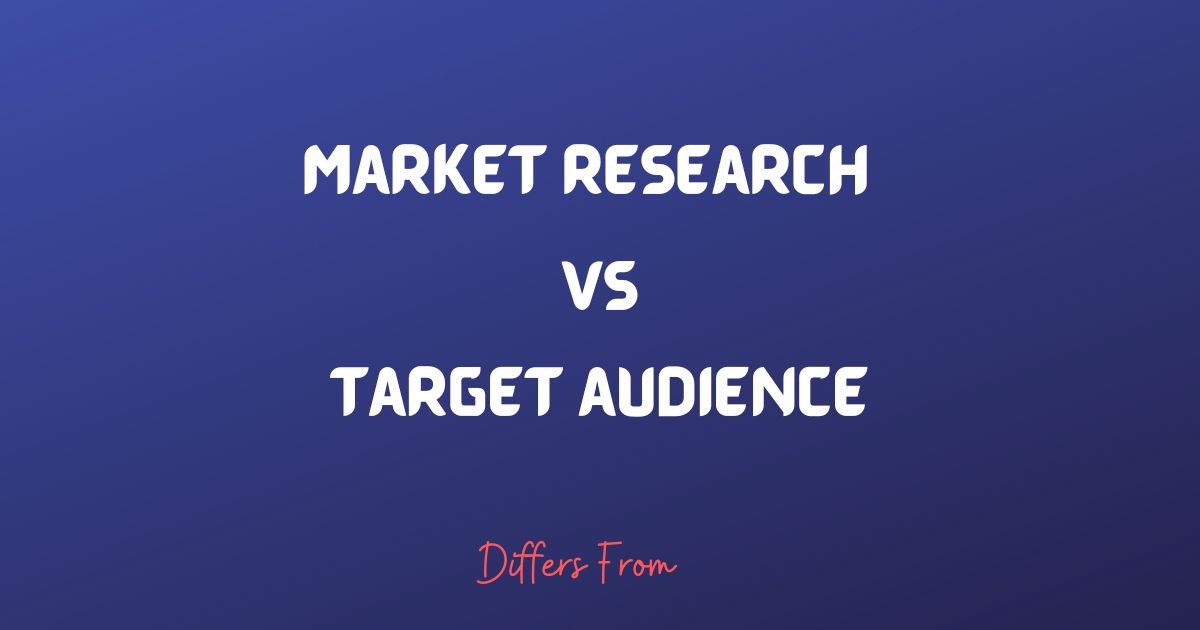When building a successful business or marketing strategy, you’ve probably heard the terms “market research” and “target audience” thrown around.
But what exactly do these terms mean, and how do they differ from each other?
In this blog post, we’ll break it down for you in simple terms. We’ll help you understand the distinctions between market research and defining your target audience, so you can use these tools effectively to boost your business.
Let’s get started by unraveling the basics of these critical concepts.
Difference between market research and target audience
| Market Research | Target Audience | |
| Definition | Market research involves the collection and analysis of data and information about a particular market, including its size, trends, competition, and customer behavior. | The target audience refers to a specific group of individuals or businesses that a product or service is intended to reach and appeal to. |
| Purpose | The primary purpose of market research is to gain a comprehensive understanding of a market as a whole. | The purpose of defining a target audience is to identify the ideal customers who are most likely to be interested in and purchase a product or service. |
| Scope | Market research encompasses a broader view of the entire market, including demographics, industry analysis, and market potential. | Identifying a target audience involves focusing on a specific subset of the market with shared characteristics and preferences. |
| Data Sources | Data sources for market research can include surveys, interviews, industry reports, and statistical data. | Defining a target audience often relies on market research data but is more specific and tailored to the product or service. |
| Analysis | Analysis in market research involves studying market trends, competitor strategies, and broader market dynamics. | Analysis of the target audience focuses on understanding the needs, preferences, and behaviors of a specific group of potential customers. |
| Decision-Making | Market research informs overall business strategies, product development, and market entry decisions. | Defining a target audience guides marketing efforts, communication strategies, and product positioning. |
| Timing | Market research is typically conducted before identifying a specific target audience to understand the market landscape. | Identifying a target audience comes after market research when the company has a product or service to offer. |
| Broad vs. Specific | It provides a broad understanding of the market and its various segments. | It narrows the focus to a specific group within the market. |
| Flexibility | Market research can be more adaptable and used for different products or services within the same industry. | Identifying a target audience is specific to a particular offering and may change for different products or campaigns. |
| Implementation | The insights from market research influence the long-term strategic decisions of a company. | The target audience definition directly impacts short-term marketing efforts and communication strategies. |
What is Market research?
Market research is a crucial process for businesses to gain insights into their target market. It involves collecting and analyzing data about customer preferences, buying habits, competitors, and industry trends.
Through techniques like surveys, focus groups, and data analysis, market research helps identify opportunities, understand consumer behavior, and make informed business decisions.
It can also involve studying market segmentation, pricing strategies, and product positioning. Ultimately, market research helps businesses stay competitive and meet customer needs more effectively.
What is the Target audience?
Understanding the target audience goes beyond demographics. It involves delving into their psychographics, such as values, interests, attitudes, and lifestyles.
This deeper understanding helps businesses create targeted marketing messages and strategies that resonate with their audience on a more personal level.
By understanding their motivations and behaviors, businesses can tailor their offerings to meet the specific needs and desires of their target audience.
Comparison between market research and target audience
Market research and target audience analysis are both essential components of effective marketing strategies. While they are interconnected, there are distinct differences between the two.
Scope:
- Market research is a broader process that involves gathering and analyzing information about the overall market. This includes data on industry trends, competitors, economic conditions, and consumer behavior.
- Identifying a target audience is a more specific and focused process. It involves defining a particular group of individuals who are most likely to be interested in your product or service.
Purpose:
- The primary purpose of market research is to gain a comprehensive understanding of the market as a whole. It helps businesses identify opportunities, threats, and market dynamics.
- The primary purpose of defining a target audience is to tailor marketing efforts to a specific group of potential customers. It helps in personalizing messages and strategies to resonate with this specific group.
Methods:
- Market research can involve a wide range of data collection methods, such as surveys, focus groups, data analysis, and competitive analysis. It often deals with a large dataset.
- Target audience identification is based on demographics, psychographics, and behavior. It often uses market segmentation to create detailed customer profiles.
Outcome:
- The outcome of market research is a holistic view of the market landscape, which helps businesses make informed decisions about their products, services, and marketing strategies.
The outcome of defining a target audience is a clear understanding of who your ideal customer is. This knowledge guides your marketing campaigns, product development, and communication strategies.
Interesting facts about market research and target audience
- Market research helps businesses understand consumer preferences, buying behaviors, and market trends, enabling them to make data-driven decisions.
- Target audience analysis focuses on identifying the specific group of individuals that a product or service is intended for, going beyond demographics to uncover psychographic insights.
- Market research can involve primary research methods like surveys, interviews, and observations, as well as secondary research utilizing existing data and reports.
- Target audience analysis utilizes various research techniques, including persona development, focus groups, social media listening, and consumer profiling.
- Market research helps businesses identify market gaps, competitive advantages, and potential areas for growth.
- Target audience analysis helps businesses create targeted marketing messages and strategies that resonate with their ideal customers.
- Market research can involve analyzing industry reports, conducting competitor analysis, and monitoring market trends.
- Target audience analysis helps businesses understand customer motivations, pain points, and preferences, allowing for more effective product development and positioning.
- Market research can uncover new market segments or niches a business can target.
- Target audience analysis helps businesses identify influencers and opinion leaders who can influence their target audience’s buying decisions.
- Market research helps businesses assess the feasibility and potential success of new products or services before launch.
- Target audience analysis assists businesses in developing personalized marketing campaigns and delivering tailored experiences to their target customers.
Final Words
Market research focuses on understanding the overall market landscape, industry trends, and customer preferences, enabling businesses to make informed decisions about product development, pricing, and marketing strategies.
Target audience analysis, on the other hand, hones in on specific groups of individuals, delving into their characteristics, behaviors, and psychographics.
It helps businesses create targeted marketing messages, design personalized campaigns, and deliver tailored experiences that resonate with the identified audience.
Both approaches are essential for effective marketing, with market research providing a broader market perspective and target audience analysis enabling focused and customized strategies.

